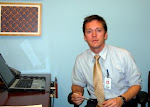Tsothle looked intently at the cartoon figures, smiling. Occasionally she nodded. At one moment, she pointed and, raising her eyebrows, asked a question that I did not understand. Gloria, the Setwsana-speaking nurse who was discussing the pictures with her, answered, and she said “Oh. Okay,” nodding again.
The cartoon images shown to her were of HIV and how it works in the body. Though this child was nearly thirteen, she had no idea. She has been on ARVs for over ten years now, and nobody had ever told her why, for her family wished to keep it a secret and those providing her with the medicines assented.
This past week Tsothle had her first visit to the Baylor Centre, and as I was about to walk into the exam room, one of our nurses pulled me into another room to warn about Tsothle’s delayed disclosure status.
“Disclosure status”, as you might guess, refers to how much we (the guardians and/or health professionals) tell a child about something, in this case HIV. Disclosure terrifies us so much that we (family and health care providers alike) often lie to children, or simply tell them nothing. We do this because we want to protect the child, and of course protect ourselves from discomfort, guilt, and whatever other feelings come from telling an innocent young human being that they were born carrying a value-laden disease that, if not kept at bay by treatment, can maim and kill.
Tsothle came with a pressed, navy school uniform, intelligent eyes, a kind disposition, and ten years—2-3 centimeters—of worn-out medical records, mostly handwritten in MD hieroglyphics, many pages cloth-like from the years of crumpling and the residue of several hundred hands. Along with her medical archive, Tsothle came with a level of HIV in her blood that told me that she was either not taking her meds or that the virus was resistant to them (ie not at bay).
I looked for evidence to explain the high levels of HIV in her body, and found a two-year old lab result that told me that she was resistant to some first-line ARVs in 2007. Given that HIV medicines usually only stop working when not taken appropriately, I began to worry that Tsothle was now resistant to the second line of medicines that she had been taking over the past 2 years because she had not been taking them either.
I looked for quantitative evidence regarding her adherence to medication, only to find that it was never monitored. “Have you ever had your pills counted?” I asked.
“No.” Tsothle said.
“Not once?” Both mother and daughter nodded in confirmation. (Note: Here in Botswana, saying or indicating yes confirms a negative. Example: Q: “So you don’t want fries with that?” A: “Yes.” Meaning: No fries.)
The good thing about pill counts is that, unless manipulated by a mathematically-minded child or caregiver, they provide quantitative evidence of a behavior (or lack thereof). When it comes to qualitatively assessing desirable/undesirable behavior (asking, for example), people often distort the truth.
“Have you been missing doses?” I asked Tsothle.
“Yes.”
“So you are not taking all of your medicines?”
“Yes.”
“Thank you for being honest,” I told her. A heaviness crept over me as I realized that Tsothle was about to learn that several people close to her had not been so truthful.
I asked Gloria if she would step outside and discuss the advantages of disclosure with the mother, which she did while I examined the child and asked her about school. The mother, hearing the advantages of our simple, step-wise explanatory process, immediately agreed that we should start telling Tsothle the truth.
And so Grace began telling the story about the soldiers that protect the body, the “bad guys” who wish to do the soldiers harm, and the medicines that give the soldiers stronger armor and make the bad guys sleepy. While the cartoons that we use to tell the story do not resemble CD4 cells or the ice-cream cone-shaped human immunodeficiency virus, the role of the protagonists and antagonists are clear. We avoid scientific names, but we do tell the child the truth.
After Gloria finished, Tsothle asked if she could take a dose of her ARVs now.
“Twice a day is best,” Gloria said.
“Yes,” I confirmed. “Twice a day only…Come back in two weeks and let’s count your medicines and check to make sure those bad guys are asleep.”
“They will be,” Tsothle said.
The mother smiled, her face wearing the kind, thankful, relieved expression that makes this work seem like anything but.




